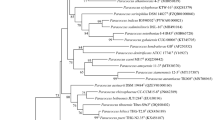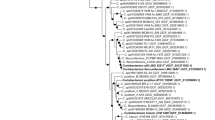Abstract
A Gram stain-negative, aerobic, motile by gliding, rod-shaped bacterial strain CAU 1569T was isolated from marine sediment on Shido Island in Incheon. It grew at 20–37 °C (optimum, 30 °C), pH 6.0–9.0 (optimum, 7.0), 2–6% NaCl (w/v) (optimum, 2%). Phylogenetic analysis based on 16S rRNA gene sequence indicated that strain CAU 1569T formed a distinct lineage with only the type strain of Snuella. Strain CAU 1569T showed high similarity to S. lapsa KACC 14152T (95.8%), Mariniflexile gromovii KMM KCTC 12570T, Aestuariibaculum marinum KCTC 52521T (95.4%), A. suncheonense KACC 16186T (94.6%) and Yeosuana aromativorans KCCM 42019T (94.4%). The genome contained 57 contigs, 3,437 protein-coding gene, 3 rRNAs (5, 16, and 23S), 43 tRNAs, and with a 35.7 mol% G + C content. The DDH value between strain CAU 1569T and S. lapsa KACC 14152T was 39.4 ± 0.6%. The only isoprenoid quinone was menaquinone 6 (MK-6). The major fatty acids were iso-C15:0, C15:1-iso G, and C17:0 iso 3-OH. Strain CAU 1569T contained diphosphatidylglycerol, aminoglycolipid, unidentified aminolipid, and three unidentified lipids. Based on phylogenetic, genomic, physiologic, and chemotaxonomic characterizations, strain CAU 1569T represents a novel Snuella species, which the name Snuella sedimenti sp. nov. is proposed. The type of strain is CAU 1569T (= KCTC 82409T = MCCC 1K05670T).

Similar content being viewed by others
Data availability
The GenBank/EMBL/DDBJ accession number for the 16S rRNA gene sequence of strain CAU 1569T is MN544292 and the whole genome accession number is NZ_JAELVQ000000000.
References
Aziz RK, Bartels D, Best AA, DeJongh M, Disz T, Edwards RA, Formsma K, Gerdes S, Glass EM, Kubal M, Meyer F, Olsen GJ, Olson R, Osterman AL, Overbeek RA, McNeil LK, Paarmann D, Paczian T, Parrello B, Pusch GD, Reich C, Stevens R, Vassieva O, Vonstein V, Wilke A, Zagniko O (2008) The RAST server: rapid annotations using subsystems technology. BMC Genomics 9:75
Bernardet JF, Bernardet JF, Flavobacteriaceae FI, Reichenbach, (1992). In: Krieg NR, Ludwig W, Whitman WB, Hedlund BP, Paster BJ (eds) Bergey’s manual of systematic bacteriology, 4, 2nd edn. Springer, pp 106–111
Bernardet JF, Segers P, Vancanneyt M, Berthe F, Kersters K, Vandamme P (1996) Cutting a Gordian knot: emended classification and description of the genus Flavobacterium, emended description of the family Flavobacteriaceae, and proposal of Flavobacterium hydatis nom. nov. (basonym, Cytophaga aquatilis Strohl and Tait 1978). Int J Syst Bacteriol 46:128–148
Bernardet JF, Nakagawa Y, Holmes B, Subcommittee on the taxonomy of Flavobacterium and Cytophaga-like bacteria of the International Committee on Systematics of Prokaryotes (2002) Proposed minimal standards for describing new taxa of the family Flavobacteriaceae and emended description of the family. Int J Syst Evol Microbiol 52:1049–1070
Bhumika V, Srinivas TNR, Kumar PA (2013) Flavobacterium nitratireducens sp. nov., an amylolytic bacterium of the family Flavobacteriaceae isolated from coastal surface seawater. Int J Syst Evol Microbiol 63:2490–2496
Choi J, Lee D, Jang JH, Cha S, Seo T (2018) Aestuariibaculum marinum sp. nov., a marine bacterium isolated from seawater in South Korea. J Microbiol 56:614–618
Chun J, Oren A, Ventosa A, Christensen H, Arahal DR, da Costa MS, Rooney AP, Yi H, Xu XW, Meyer SD, Trujillo ME (2018) Proposed minimal standards for the use of genome data for the taxonomy of prokaryotes. Int J Syst Evol Microbiol 68:461–466
Embley TM, Wait R (1994) Structural lipids of eubacteria. In: Donnell O (ed) Chemical methods in prokaryotic systematics. Chichester. John Wiley and Sons, pp 121–161
Ezaki T, Hashimoto Y, Yabuuchi E (1989) Fluorometric deoxyribonucleic acid-deoxyribonucleic acid hybridization in microdilution wells as an alternative to membrane filter hybridization in which radioisotopes are used to determine genetic relatedness among bacterial strains. Int J Syst Bacteriol 39:224–229
Felsenstein J (1981) Evolutionary trees from DNA sequences: a maximum likelihood approach. J Mol Evolution 17:368–376
Felsenstein J (1985) Confidence limits on phylogenies: an approach using the bootstrap. Evolution 39:783–791
Fitch WM (1971) Toward defining the course of evolution: minimum change for a specific tree topology. Syst Zool 20:406–416
Gavriilidou A, Gutleben J, Versluis D, Forgiarini F, van Passel MW, Ingham CJ, Smidt H, Sipkema D (2020) Comparative genomic analysis of Flavobacteriaceae: insights into carbohydrate metabolism, gliding motility and secondary metabolite biosynthesis. BMC Genomics 21:1–21
Jeong SH, Park MS, Jin HM, Lee K, Park W, Jeon CO (2013) Aestuariibaculum suncheonense gen. nov., sp. nov., a marine bacterium of the family Flavobacteriaceae isolated from a tidal flat and emended descriptions of the genera Gaetbulibacter and Tamlana. Int J Syst Evol Microbiol 63:332–338
Kim JH, Kim KY, Hahm YT, Kim BS, Chun J, Cha CJ (2008) Actibacter sediminis gen. nov., sp. nov., a marine bacterium of the family Flavobacteriaceae isolated from tidal flat sediment. Int J Syst Evol Microbiol 58:139–143
Kim OS, Cho YJ, Lee K, Yoon SH, Kim M, Na H, Park SC, Jeon YS, Lee JH, Yi H, Won S, Chun J (2012) Introducing EzTaxon-e: a prokaryotic 16S rRNA gene sequence database with phylotypes that represent uncultured species. Int J Syst Evol Microbiol 62:716–721
Kim JH, Ward AC, Kim W (2015) Kangiella chungangensis sp. nov. isolated from a marine sand. Antonie Van Leeuwenhoek 107:1291–1298
Komagata K, Suzuki K (1987) Lipids and cell-wall analysis in bacterial systematics. Methods Microbiol 19:161–207
Kumar S, Stecher G, Tamura K (2016) MEGA7: molecular evolutionary genetics analysis version 7.0 for bigger datasets. Mol Biol Evol 33:1870–1874
Kwon KK, Lee HS, Jung HB, Kang JH, Kim SJ (2006) Yeosuana aromativorans gen. nov., sp. nov., a mesophilic marine bacterium belonging to the family Flavobacteriaceae, isolated from estuarine sediment of the South Sea Korea. Int J Syst Evol Microbiol 56:727–732
Minnikin DE, O’Donnell AG, Goodfellow M, Alderson G, Athalye M, Schaal A, Parlett JH (1984) An integrated procedure for the extraction of bacterial isoprenoid quinones and polar lipids. J Microbiol Methods 2:233–241
Nam SW, Kim W, Chun J, Goodfellow M (2004) Tsukamurella pseudospumae sp. nov., a novel actinomycete isolated from activated sludge foam. Int J Syst Evol Microbiol 54:1209–1212
Nedashkovskaya OI, Kim SB, Han SK, Lysenko AM, Rohde M, Rhee MS, Frolova GM, Falsen E, Mikhailov V, Bae KS (2004) Maribacter gen. nov., a new member of the family Flavobacteriaceae, isolated from marine habitats, containing the species Maribacter sedimenticola sp. nov., Maribacter aquivivus sp. nov., Maribacter orientalis sp. nov. and Maribacter ulvicola sp. nov. Int J Syst Evol Microbiol 54:1017–1023
Reichenbach H (1991) The order Cytophagales. In: Truper HG, Dworkin M, Harder W, Schleifer KH (eds) The Prokaryotes. Springer, pp 3631–3675
Saitou N, Nei M (1987) The neighbor-joining method: a new method for reconstructing phylogenetic trees. Mol Biol Evol 4:406–425
Sasser M (2006) Bacterial identification by gas chromatographic analysis of fatty acids methyl esters (GC-FAME). Microbial ID Inc
Smibert RM, Krieg NR (1994) Phenotypic characterization. In: Gerhardt P, Murray RG, Wood WA, Krieg NR (eds) Methods for general and molecular bacteriology. American Society for Microbiology, pp 607–654
Wang Q, Liu F, Zhang DC (2020) Pelagihabitans pacificus gen. nov., sp. nov., a member of the family Flavobacteriaceae isolated from a deep-sea seamount. Int J Syst Evol Microbiol 70:4569–4575
Wayne LG, Brenner DJ, Colwell RR, Grimont PAD, Kandler O, Krichevsky MI, Moore LH, Moore WEC, Murray RGE, Stackebrandt E, Starr MP, Trüper HG (1987) International committee on systematic bacteriology. report of the ad hoc committee on reconciliation of approaches to bacterial systematics. Int J Syst Bacteriol 37:463–464
Wolfe AJ, Berg HC (1989) Migration of bacteria in semisolid agar. Proc Natl Acad Sci USA 86:6973–6977
Yi H, Chun J (2011) Snuella lapsa gen. nov., sp. nov., isolated from tidal flat sediment. Int J Syst Evol Microbiol 61:2469–2474
Acknowledgements
This work was supported by a grant from the National Institute of Biological Resources (NIBR), funded by the Ministry of Environment (MOE) of the Republic of Korea (NIBR201902203), and the Chung-Ang University Research Grants in 2019.
Author information
Authors and Affiliations
Corresponding author
Ethics declarations
Conflict of interest
The authors declare no competing interests.
Additional information
Communicated by Erko Stackebrandt.
Publisher's Note
Springer Nature remains neutral with regard to jurisdictional claims in published maps and institutional affiliations.
Supplementary Information
Below is the link to the electronic supplementary material.
Rights and permissions
About this article
Cite this article
Kim, JH., Weerawongwiwat, V., Yoon, JH. et al. Snuella sedimenti sp. nov., isolated from marine sediment. Arch Microbiol 203, 5437–5443 (2021). https://doi.org/10.1007/s00203-021-02528-8
Received:
Revised:
Accepted:
Published:
Issue Date:
DOI: https://doi.org/10.1007/s00203-021-02528-8




